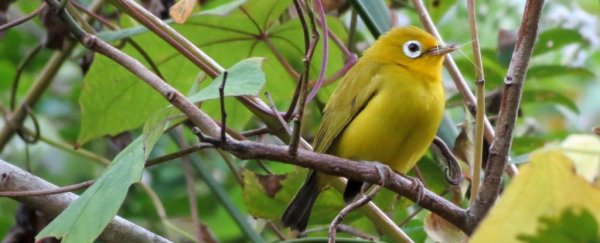Given the fervour with which naturalists scoured Southeast Asia in the 19th century looking for new bird species, you'd think the region would be tapped out. But nature can still find ways to sneak up on us: Two previously undescribed species have only just been discovered in Indonesia.
They both belong to the genus Zosterops, and both are found in the same area.
The Wakatobi white-eye hails from the collective Wakatobi Islands in Sulawesi; and the Wangi-wangi white-eye is found only on Wangi-Wangi, the northernmost of the Wakatobi Islands.
"To find two new species from the same genus of birds in the same island is remarkable," said zoologist Nicola Marples of Trinity College Dublin.
And yet, while they look similar, the two species have rather different origins - which adds some interesting fuel to the debate about how species are defined.
 The Wangi-wangi white-eye (left) and the Wakatobi white-eye (right). (Nicola Marples and David Kelly)
The Wangi-wangi white-eye (left) and the Wakatobi white-eye (right). (Nicola Marples and David Kelly)
The Wakatobi white-eye is not actually a newly discovered bird. The first mention of the Wakatobi population in scientific literature was by German ornithologist Ernst Hartert in 1903, who referred to it as a separate species, Zosterops flavissimus.
However, this population was subsequently subsumed as a subspecies of the lemon-bellied white-eye (Z. chloris), and was thereafter referred to as Z. chloris flavissimus.
But the island-dwelling white-eyes are a lot like Darwin's famous island-dwelling finches, which colonise islands and split into separate, isolated populations that rapidly evolve along differing pathways.
Marples and her team sequenced the DNA of the birds, and conducted phylogenetic and genetic analyses. They found that Z. c. flavissimus split from its mainland relatives sometime in the last 800,000 years, and believe that there was enough diversification from Z. chloris to classify the Wakatobi white-eye as a separate species.
"There is a clear split between the Z. c. flavissimus population on the Wakatobi Islands and all other Z. chloris populations," the researchers wrote in their paper.
The Wangi-wangi white-eye, on the other hand, is much older. Its closest living relatives are the Kolombangara white-eye (Z. murphyi), the Rennell white-eye (Z. rennellianus), and the Louisiade white-eye (Z. griseotinctus).
 The Wangi-wangi white-eye. (James Eaton)
The Wangi-wangi white-eye. (James Eaton)
All three are found in the Solomon Islands, over 3,000 kilometres (1,864 miles) from Wangi-Wangi. How it got so far away from its relatives is still a mystery.
Because the Wangi-wangi white-eye is confined to such a small region, the researchers noted that it's in grave danger of extinction via habitat loss. Yet it was first identified by Marples and colleagues in 2003 - and it's still awaiting formal classification.
The team hopes their research will highlight the perils of administrative delays in officially describing a new species to conservation biology.
"These discoveries are not just of evolutionary interest - they will also be of real conservation relevance," said zoologist Darren O'Connell of University College Dublin.
"By highlighting the unique species special to the Wakatobi Islands we can help safeguard the remaining habitats on the islands, which are under huge pressure. We ultimately hope to have the islands recognised as an Endemic Bird Area so that they receive more conservation support."
The research has been published in the Zoological Journal of the Linnean Society.
